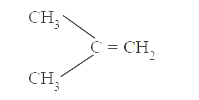Show cis and trans structures of C6H5-CH=CH-C6H5Solution in Punjabi
Silver salt of carboxylic acid is treated with chlorine or bromine in the presence of carbon tetrachloride solution. Alkyl or aryl halide with one carbon atom less than the acid is formed.
Topper's Solved these Questions
- HALOALKANES AND HALOARENESBOOK - OMEGA PUBLICATIONCHAPTER - HALOALKANES AND HALOARENESEXERCISE - MULTIPLE CHOICE QUESTIONS (MCQS)
20 Videos
- H.P BOARD MARCH,2016BOOK - OMEGA PUBLICATIONCHAPTER - H.P BOARD MARCH,2016EXERCISE - SERIES-C
25 Videos
- POLYMERS BOOK - OMEGA PUBLICATIONCHAPTER - POLYMERS EXERCISE - QUESTIONS
98 Videos
Similar Questions
Ethyl alcohol gives ethyl chloride with the help of
View SolutionThe apperance of colour in solid alkeli metal halide is generally due to
View SolutionExplain addition and condensation polymers giving one example in each case.
View SolutionYou are given two compound First, you name both of them the same yet, are they really same structure, or they some how different ?Carefully inspection should convince you that they are indeed different. Now, how their physical and chemical properties differ? Generally (i) cis-isomer has more diplomoment than trans-isomer (ii) cis-is less stable than trans (iii) boiling points of cis isomers are than those of trans isomers (remember boiling points are directly related to polarity which is determined by dipolemoment) chemical reactivities of cis and trans also differ from each other. Arrange the following compounds in the increasing order of the boiling poiints CH_(3)-underset(A)CH=CH-CH_(3)(cis),CH_(3)-underset(B)CH=CH-CH_(3)(trans) CH_(3)-underset(C)CHCl=CH(cis),CH_(3)-underset(D)CH=CHCl(trans)
View SolutionMatch the column I and II. (Matrix) {:(,"Column I",,"Column II"),((a),H_(3)C-CH=CH-CH_(3),(p),"Dipole" "(cis" gt "trans)"),((b), H_(3)C-CH=CH-CN,(q),"Dipole" "(trans" gt "cis)"),((c),H_(3)C-CH=CH-Cl,(r),"Melting point" "(trans" gt "cis)"),((d),Cl-CH=CH-Cl,(s),"Boiling point " "(cis" gt "trans)"):}
View Solution(a) CH3−CH=CH−CH=CH−C2H5 (Molecule with dissimilar ends).
Here n=2, So Number of G.I = 4 [cis, cis), (trans, trans), (cis, trans,), (trans, cis)]
(b) CH3−CH=CH−CH=CH−CH3 (Molecule with similar ends)
Here n=2, So Number of G.I =3 [(cis, cis), (trans, cis), (cis, trans) = (trans, cis)]
(c) CH3−CH=CH−CH=CH−CH=CH−CH3 (Molecule with similar ends)
Here n=3, So Number of G.I =6
[(cis, cis, trans)= (trans, cis, cis) (cis, trans, trans) = (trans, trans, cis), (cis, cis, cis) (trans, trans, tans), (cis, trans, cis, (trans, cis, trans)]
(d) Let us draw the total stereoisomers of CH3−⋆CH∣OH−⋆CH∣OH−⋆CH∣OH−CH3
(e) Let us draw the total stereoisomers of CH3−⋆CH∣OH−⋆CH∣OH−CH3
(f) Let us draw the total stereoisomers of CH3−CH(OH)−CH2−CH=CH−CI
View SolutionWrite of the following compounds will show cis-trans isomerism ? (i) (H_3C)_2C=CH-C_2H_5 , (ii) H_2C=CBr_2 , (iii) C_6H_5CH=CHCH_3 , (iv) H_3C-CH=C Cl(CH_3)
View Solutionनिम्न संरचनाओं के IUPAC नाम लिखिए-
(8) CH3−CH2−CH2−CI−CI∣C−CH3∣CH−CH∣CI−CH−CH2−Br−CH2−CH2−CH3
View SolutionDraw cis trans isomers for the following comounds (a) 2 lchoro 2 butene (b) CH_(3)-CH=CH-CH_(2)-CH_(3)
View SolutionWhich of the following compounds will show cis-trans isomerism? (i) (CH_3)_2C=CH-C_2H_5 (ii) CH_2=CBr_2 (iii) C_6H_5CH=CH-CH_3 (iv) CH_3CH=C Cl CH_3
View SolutionArrange the following in the increasing order of stability.
CH3CH2CH=CH2,CH3CH=CHCH3(cis),CH3CH=CHCH3 (trans)

View SolutionHow many of the following posses non-zero dipole moment
Cis ICH=CHI , cisBrCH=CHBr, tansCH3CH=CHCl, trans CH3−CH=CH−CH3, cisCHCl=CHCl, transCHCl=CHCl
View SolutionFill in the blanks and rewrite the balanced equations. C6H5-COOH + …… --------->.........+ phosphorous oxychloride + HCl
View SolutionHow many of the following posses non-zero dipole moment Cis ICH= CHI , cis BrCH = CHBr , "tans"CH_3CH = CHCl, "trans " CH_3 - CH = CH-CH_3 , cis CHCl=CHCl , "trans" CHCl=CHCl
View SolutionPredict the order of reactivity by SN1OR SN2 reactions.C6H5C(CH3)(C6H5)CI,C6H5-CH -(CH3)Cl , C6H5-CH2-Cl , C6H5-CH-C6H5-Cl
View SolutionWhich of the following compunds exhibit gemetrical isomerism? Draw their cis-trans isomers (i) CH3−CH=CCl2(ii) CH3−CH=CHCl(iii)ClCH=CHCl(IV)CH3−CH2−CH=CH2
View Solution
